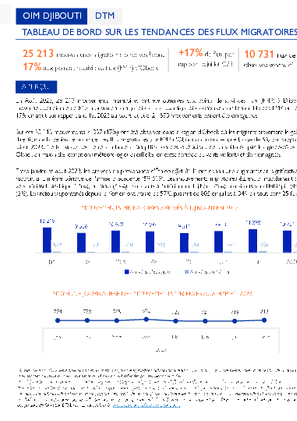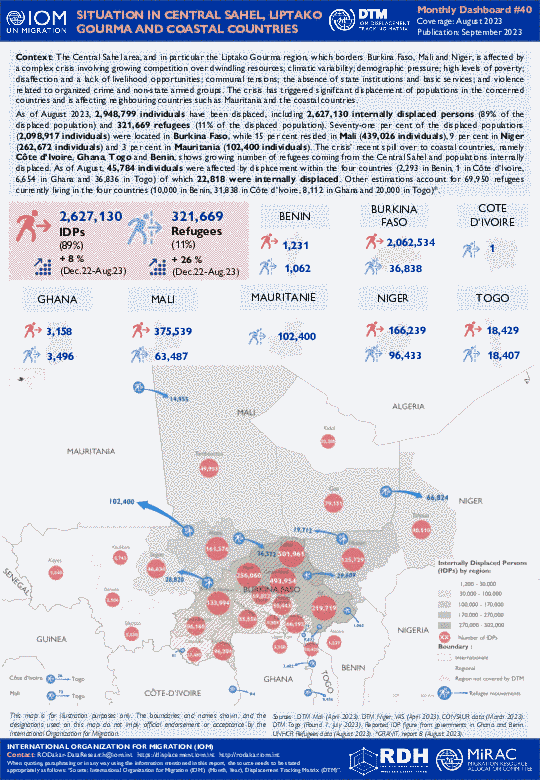-
Countries
-
Data and Analysis
-
Special Focus
-
Crisis Responses

Contact
DTM Europe, ROViennaDataResearch-Newsletter@iom.int
Language
English
Location
Austria
Snapshot Date
Sep 20 2023
Activity
- Survey
The Russian full-scale invasion of Ukraine on 24 February 2022 forced millions of Ukrainians and third-country nationals living in Ukraine to flee their homes, many crossing international borders. With the activation of the Temporary Protection Directive (2001/55/EC), the European Union introduced a regime that grants those who fled Ukraine and who fall under the Council Implementing Decision (EU) 2022/382 a residence permit, as well as access to social welfare, education, employment and health care. By December 2022, there were 87,570 Temporary Protection holders in Austria, where the system of basic care (Grundversorgung) provides immediate support and housing for asylum-seekers and other non-Austrian citizens who are in need of protection and assistance. Unlike asylum-seekers, for whom the system was originally established, the majority of displaced persons from Ukraine (i.e. 72% of all Ukrainians receiving basic care) live in private accommodation instead of organized accommodation provided by the authorities. According to the survey, of those in private accommodation, 66 per cent (+/- 4.9) rent and 27 per cent (+/- 4.6) are hosted by friends, relatives or people not known to them before arrival. The fact that a significant proportion of displaced persons from Ukraine is
living in private accommodation presents particular challenges and potential vulnerabilities. \Seventy-seven (77) per cent of adult Temporary Protection holders residing in Austria are female and 35 per cent of Temporary Protection holders are children, representing a group that is at an increased risk of vulnerability to violence, exploitation and abuse, including human trafficking. Although most offers of private assistance are well intentioned, living outside of the organized housing system poses challenges to monitoring and protection measures. Information about living conditions in private accommodation is limited, including on potential risks of violence, exploitation and abuse encountered by displaced persons from Ukraine.
To fill this data gap, IOM Austria took part in a panel data collection that was jointly implemented by the Austrian Federal Ministry of the Interior and the Austrian Integration Fund. In the third wave of the survey, which took place from 17 January to 8 February 2023, a set of questions on the topic area was added. The self-administered online survey was sent to 7,274 displaced persons in Austria. Of these surveys, 552 were completed and submitted.
One of the objectives of this non-representative survey was to identify risk factors of experiencing violence, exploitation or abuse when accommodated in private versus organized, public housing. The data collected support the anecdotal evidence that vulnerability to exploitation and housing are linked. This Survey Report summarizes the data collection findings with the objective of making the information collected accessible in order to strengthen existing protection, assistance and awareness-raising interventions and policies.

Contact
DTM Djibouti, DTMDjibouti@iom.int
Language
French
Location
Djibouti
Period Covered
Aug 01 2023
Aug 31 2023
Activity
- Flow Monitoring
En août 2023, 25 213 mouvements migratoires ont été observés aux points de suivi des flux (FMP) à Dijibouti, avec une moyenne quotidienne de 813 mouvements migratoires. Les flux migratoires observés sur l'ensemble des FMP ont augmenté de 17 % en août par rapport au mois à juillet 2023 au cours duquel 21 573 mouvements ont été enregistrés.
Sur ces 25 213 mouvements, 4 357 (17 %) ont été observés dans la région d'Obock, où les migrants traversent le golfe d'Aden en direction de la péninsule arabique. Les flux migratoires aux FMP d'Obock ont connues une baisse de 6% par rapport au mois de juillet 2023. Cette baisse peut être attribuée à l'amplification des opérations de surveillance par les garde-côtes djiboutiens à Obock en raison des conditions météorologiques difficiles en cette période de vents violents et de mer agitée.
Entre janvier et août 2023, les arrivées en provenance d'Éthiopie (84 814) ont connu une augmentation significative de 42% par rapport à la même période de l'année précédente (59 609). Les mouvements migratoires ont été principalement : transitants vers la péninsule arabique (45%), entrants (43%), transitants à l'intérieur de Djibouti (5%), transitants vers l'Éthiopie (4%), et sortants (3%). Les retours spontanés depuis le Yémen ont baissé de 57%, passant de 805 en juillet à 349 en août, y compris les femmes (7%).
The Central African Republic (CAR), which has experienced continuous volatility for the past two decades, has been riddled by a crisis which ignited in 2012 with a violent takeover of power and has developed into a complex protracted state of permanent insecurity and fragility which has spilled over into neighbouring countries. The crisis is characterized by power struggles amongst elites, the absence of state institutions and public investment, religious and ethnic tensions and disputes for the control of key resources. More recently, the crisis in Sudan, which started in April 2023, is affecting the eastern part of the CAR witnessing arrivals of displaced populations. As of August 2023, 3,865,278 individuals were affected, including 514,547 internally displaced persons (13% of the displaced population), 2,063,885 returnees former IDPs (54%), 503,019 returnees from abroad (13%) and 783,827 refugees (20%). In the CAR, the largest displaced population consists of former IDP returnees. Refugees from the CAR are primarily hosted by Cameroon (352,938 individuals, or 45% of the refugees), the Democratic Republic of the Congo (DRC) (211,274 individuals, or 27% of the refugees) and Chad (128,083 individuals, or 16% of the refugees). Nonetheless, 24,370 refugees from the Central African Republic are still living in Sudan (3% of the refugees). Since the beginning of the Sudan crisis, a total of 15,335 individuals have entered the CAR through the border in Am-Dafock. The country is home for refugees from neighbouring countries, hosting a total of 34,493 refugees coming from Sudan (24,017 individuals), the DRC (6,410 individuals), South Soudan (2,731 individuals) and Chad (1,335 individuals).
The Central Sahel area, and in particular the Liptako Gourma region, which borders Burkina Faso, Mali and Niger, is affected by a complex crisis involving growing competition over dwindling resources; climatic variability; demographic pressure; high levels of poverty; disaffection and a lack of livelihood opportunities; communal tensions; the absence of state institutions and basic services; and violence related to organized crime and non-state armed groups. The crisis has triggered significant displacement of populations in the concerned countries and is affecting neighbouring countries such as Mauritania and the coastal countries.
As of August 2023, 2,948,799 individuals have been displaced, including 2,627,130 internally displaced persons (89% of the displaced population) and 321,669 refugees (11% of the displaced population). Seventy-one per cent of the displaced populations (2,098,917 individuals) were located in Burkina Faso, while 15 per cent resided in Mali (439,026 individuals), 9 per cent in Niger (262,672 individuals) and 3 per cent in Mauritania (102,400 individuals). The crisis’ recent spill over to coastal countries, namely Côte d’Ivoire, Ghana, Togo and Benin, shows growing number of refugees coming from the Central Sahel and populations internally displaced. As of August, 45,784 individuals were affected by displacement within the four countries (2,293 in Benin, 1 in Côte d’Ivoire, 6,654 in Ghana and 36,836 in Togo) of which 22,818 were internally displaced. Other estimations account for 69,950 refugees currently living in the four countries (10,000 in Benin, 31,838 in Côte d’Ivoire, 8,112 in Ghana and 20,000 in Togo)*.


